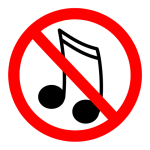A good melody tells a story. It doesn’t just help tell the story of the words; it has its own story.
(Sometimes the melody’s story is very different from the story in the words – it can also function as subtext to the lyric).
Any good melody has drama. It starts somewhere, takes a journey, developments happen, tensions develop and are (usually) resolved. But the main thing is that the melody stay in motion, that it doesn’t feel finished until it is finished.
Like a shark, it has to move or die.
In any dramatic form – film, theater – you don’t resolve your story until the end. Because the resolution is the end. A melody’s pretty similar (songs are also a performance art).
And the easiest way to make a melody feel finished is to land strongly on a note that’s also the root note of the chord under it – for example, while your melody’s moving along, landing on a big C note over a C chord (especially in the key of C!). If I do that, that melody will feel done, that story feels finished. Try it yourself.
But if that melody drops on any other note, it will not yet feel resolved. Try, over the C chord, an ‘E’ or a ‘G’ , a ‘B’ or ‘Bb’. Then the melody’s still in motion, the story has further to go. Which is what you want if you want to keep the listener’s interest.
The mistake of the premature root in the melody is something less experienced songwriters are prone to. It can, all by itself, make you sound like a less experienced songwriter!
(And I don’t mean to imply that all melodies resolve to the root, or should resolve to the root. Or that there should never be a root note in the melody – that’s certainly not the case. My point is that the chord’s root note is the most obvious and unmistakable ‘ending’. Many – most? – great melodies don’t end in a completely resolved way.)
On a certain level, good melodies are about building and sustaining tension, and postponing resolution (in an interesting way). Telling a story. So I suggest being very careful with roots in the melody. Be stingy with them.
Thanks for reading! Let me know your thoughts, additions, disagreements in the Comments section below:
And please share on facebook etc. by clicking these tabs –


Very well put, Tony! The only thing I can think of to add is that sometimes ending in a deliberately non-resolving way – not on the root chord, not on an expected beat, not on the root note or some combination of the three can have it’s own useful vibe. Particularly with a moody song where you want the impact of the last line to linger for a moment, leaving it unresolved can heighten the effect.
Jon,
I couldn’t agree more, and didn’t mean to imply that all melodies should resolve to the root. Just that it’s the most obvious and unmistakable resolution.
Thanks,
Tony
Jon,
See addition to the post. Thanks!
TC
This is one way to look at things. You could also say that a melody is about movement, and movement can happen by moving to and then away from the root. Consider the song Diamonds Are A Girls Best Friend – the very first downbeat of the chorus is right on the root- and the melody is on the tonic arpeggio for the first few bars. In subsequent phrases the movement is away from the tonic, and finally back to it. In between are modulations and variations. It’s never boring and it’s a great melody. There are many other examples : Here, There and Everywhere; Stardust (not in the first phrase, but bar 5; and so on. All truly great melodies.
Daniel,
Thanks for writing. Great points, and I don’t disagree with any of your comments; I think they’re just a slightly different angle on the same thing.
I was trying to address the ‘premature use of the root’, or its overuse.
I didn’t go into the idea of starting on the root, which you bring up and can be a great option. Thanks!
Best wishes,
Tony
“A good melody tells a story. It doesn’t just help tell the story of the words; it has its own story.”
This is a great first line of this post!!
Thanks, Sarah! That is really one of my most core Songwriting beliefs.
Best wishes,
Tony